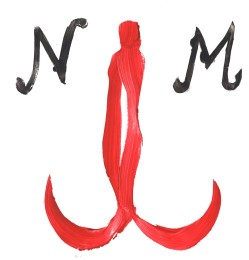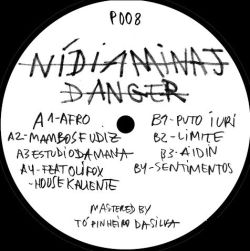P008 – NIDIA MINAJ – Danger
Vinyl 12″ / Digital
Written and produced by Nidia Minaj (A1, A2, A3, A4, B1, B2, B3, B4), DJ Olifox (A4)
Mastered by Tó Pinheiro da Silva, Artwork by Márcio Matos;
VINYL/DIGITAL: Order from us
A1 – Afro
A2 – Mambos Fudiz
A3 – Estudio Da Mana Na Casa
A4 – House Kaliente (w/ DJ OLIFOX)
B1 – Puto Iuri
B2 – Limite
B3 – Aidin
B4 – Sentimentos
PRESS RELEASE
Nidia used to dance hard with her crew of girls back in Vale da Amoreira (south bank of the Tagus river) but she soon imagined the crew producing their own music. She was kind of alone in her enthusiasm and it was only after her move to the Bordeaux area in 2011 that everything clicked together. She was 14. Nidia continued to pick up the vibes coming from the ‘hoods around Lisbon and started her own bedroom Estúdio da Mana (Sister’s studio). “Danger” is a powerful collection of tracks, it’s her own game and it’s her first physical release.
“Afro” works as an intro. Nidia presents herself over a strong African house beat; we can immediately tell there’s something different going on here;
Then “Mambos Fudiz” hits us and it’s no shame to admit we never saw it coming. A broken house beat (not actually kuduro) paves the road for all the synthetic events happening in the music. It sounds fierce, sort of apocalyptic, rave-y;
Unlike many producers who think of their DJ sets when laying out simple beat tracks with little more than 1 minute, Nidia’s shorter tracks are fully formed mini gems. “Estúdio Da Mana Na Casa” is another sort of intro / interlude, this time offering a tense and elastic main motive while the percussion stars in its own narrative;
Closing side A, Nidia teams up with DJ Olifox for an absolute dark side afro banger. It’s “House Kaliente”. Just check the loose drums and the way they’re countered at some point by these very wicked, distorted, horn-like stabs. This one sounds like it’s inventing new combinations;
In “Puto Iuri” Nidia namechecks her kid brother over a heavily oriental driven track. Africa meets the Orient as if a synthetic orchestra from China came ashore somewhere on East Africa to jam with local musicians;
“Limite” shows an angry mood. Again, fierce. Rave ooze spreads over the surface; claps reinforce a military kuduro vibe;
More leftfield experimentation on “Aidin”. An insane percussion grid defies rules of common sense, leaving not much space for reflexion, only some air for a vaguely acidic cloud to drift along;
“Sentimentos” completely subverts the traditional tarraxo pattern in favour of a freestyle approach. The percussion is still punishing but synth waves hover above all the chaos and actually convey some peace. We think it’s beautiful.
Vinyl 12″ individually hand-painted, hand-stamped.
+
Fierce debut of f*cked and trippy ghetto funk from 18 year-old producer Nidia Minaj. Hailing from south of Lisbon via Bordeaux, Nidia is in possession of a genuinely astonishing and exciting sound, concisely crammed with levels of detail, colour and ruggedest dancefloor funk that make other, older producers seem boring by comparison. There’s eight absolute treats inside, from the lush bump of introduction, ‘Afro’ to the auto-tune gilded crush of ghetto-dance-pop in ‘House Kaliente’ featuring DJ Olifox, and the tussle of sweeping string motifs and clipped, swanging drums in ‘Sentimentos’. We’re kinda bowled over by the refreshing uniqueness of her sound, especially in the blazing chromatic synths of ‘Estudio Da Mana Na Casa’ or the militant, grimy coda of ‘Limite’ or the twisted syncopation of ‘Aidin’, all adding up to one of the most crucial, uncontrived and direct debuts we could hope to hear. This is one to get very excited about!
Boomkat, February 2015
Seminal 12″ of global-hybrid numbers from the hotly-tipped Nidia Minaj, a startling debut that we are getting hugely excited about. Mainlining a mixture of percussive house workouts and bass-heavy electronic experimentation across eight storming tracks combining elements of bass, house and dub melded together into something new and refreshingly original sounding, a sterling debut that we urge you to check pronto.
Bleep, February 2015
“Mambos Fudiz,” finds its footing in the grating buzz of a distorted bass note, with Minaj sweeping it along via a breadth of composite rhythms and textural synths. Every few bars she airs things out for a beat or two, removing some of the parts to let you catch your breath, but before you know it she’s back at full force, approaching the beat from an eloquently differentiated angle—it’s pretty special to hear someone this young with such command over production.
The Fader, February 2015
Each release from Lisbon’s Principe Discos feels like an event, which is testament both to the attention they lavish on their records’ presentation, and to the breakneck thrills of the music emerging from their home city at the moment. Bizarrely catchy and rhythmically wayward, the kuduro-and-related bass mutations of producers like DJs Marfox and Nigga Fox and the Tia Maria Producoes crew run amok with contrasting sensations: in sound their beats feel lo-fi yet are simultaneously boxfresh and spine-snappingly crisp, while their delirious, tumble-dryer rhythms, which could appear at first awkward, in the dance are revealed to be precision-tooled interfaces between computer and body, jacking in and triggering hell to break loose. The debut 12” from Nidia Minaj (pictured above), born in Portugal but living in Bordeaux, might just be the label’s most striking to date. Her music is dazzling in all senses, a trance-inducing tangle of boxy drums, vivid swirls of synthetic melody and buzzsaw grime bass, all corralled into tracks that feel less like functional dancefloor units and more like short, sharp shocks of adrenaline. ‘Afro Master’ and ‘House Kaliente’ explode into action one minute, strafe the senses, then vanish as swiftly as they arrived. Powering Minaj’s ‘Estudio da Mana Casa’ and ‘Mambos Fudiz’ is the same rough and tumble of contradictions that formed UK funky’s engine room, with brusqueness squaring off against tenderness, and tough, bone-dry textures corralled into liquid grooves.
The Quietus, March 2015
Mais do que os acabamentos o que conta aqui é o esqueleto rítmico inusitado, a procura de novos ângulos e a fuga de tudo o que é formatado, numa música com qualquer coisa de neurótico e obsessivo. É música que tanto serve para fortalecer o físico à noite, como para activar neurónios durante o dia. Alguns temas revelam uma estrutura complexa, mas o que prevalece é a espontaneidade do gesto. Dir-se-ia que Nídia faz música como quem junta peças de lego, sem rígidos cuidados formais, às vezes parecendo indecifrável, mas deixando-se ir, e nesse movimento acabando por resultar numa música simples, apenas sua, partilhada generosamente de forma inteligível.
Ípsilon, Março 2015
The intensity parallels other localized developments, such as grime or, more recently, mahraganat, an Egyptian development from shaabi, which too has experienced a global growth in audience. The musics are equally political in their common revolt for enjoyment. The applicable phrase “It started all with a smile” recurs throughout “House Kaliente” — a collaboration between Nidia Minaj and DJ Olifox — and, just as mahraganat translates as “festival,” it seems the Lisbon sound could be fittingly characterized by a similar term were it to ultimately find a lasting name. Indeed, the intensity of Danger hits outwardly from the raw audio and overdriven percussion, but also from the sheer festive energy — something that is hard to rationalize.
The sound, however, has far sidestepped prescriptive labeling, largely due to the knotty miscellany of styles it combines. There are implications of kuduro, tarraxinha, and batida, but also techno and house. The track “Limite Master,” for example, contains fragments of rave in its saw-like synth motif. Although based in France, Minaj’s Portuguese roots also remain strong on Danger. The tracks are short and frantic, generally ceasing after a couple of minutes before reestablishing another rabid rhythmic pattern — each design as wild and zealous as the next — and are interspersed with circling textures that almost hint at intermission.
One characteristic of the music is the signing of each track through proclamations of the DJ’s handle, typically as the beat recoils for a moment — another marking of the sound. On Danger, the listener is constantly reminded of Minaj’s existence through sporadic interjections of “Nidia Minaj.” Such affirmations of the DJ’s presence are particularly significant on Danger, considering the architect is a 17-year-old schoolgirl in a generally older, male-dominated context. But make no mistake: Nidia Minaj has produced one of the most forcible works to come through this avenue, let alone recent dance music as a whole.
Tiny Mix Tapes, April 2015
——————–


